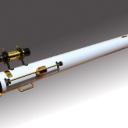Yahoo Answers is shutting down on May 4th, 2021 (Eastern Time) and beginning April 20th, 2021 (Eastern Time) the Yahoo Answers website will be in read-only mode. There will be no changes to other Yahoo properties or services, or your Yahoo account. You can find more information about the Yahoo Answers shutdown and how to download your data on this help page.
Trending News
I have been given a telescope and want to know what size viewfinder I should be using to view the stars and plants.?
2 Answers
- GeoffGLv 77 years agoFavorite Answer
I don't understand your question because most telescopes come with a suitable finder attached, either a red-dot finder or an optical finder. Could you give us more information about the telescope, which might help us understand your question?
[Edit] It just occurred to me that you might be asking about eyepieces rather than finders. A finder is a small telescope attached to the main telescope tube to help you point the telescope at objects. An eyepiece is a small optical device which is inserted into the telescope to get different magnifications. The longer the focal length of the eyepiece, the lower the magnification, and that's what you want for most viewing. So, if your telescope came with 25mm and 10mm eyepieces, you will use the 25mm (low power) most of the time.
- 7 years ago
It is very difficult to make eyepiece suggestions without knowing your telescope (aperture and focal length). From there, it is easy to work out a size range since the magnification = telescope focal length divided by eyepiece focal length.
The maximum magnification will depend on the scope, but a general rule of thumb is to consider any magnification giving an exit pupil less than 0.5mm is likely to be suboptimum. The exit pupil = aperture in mm divided by magnification. Also any magnification that is too low as to cause the exit pupil to be bigger than around 6mm/7mm will also be suboptimum. I would select eyepieces that yield: 6mm exit pupil, 3mm exit pupil, 1mm exit pupil, and 0.5mm exit pupil, at least to begin with.
As an example, lets pretend you have a 100mm/900mm refractor. A 6mm exit pupil eyepiece would be 100/M = 6, M = 16.67. Thus 16.67 = 900/E, E = 900/16.67 => 54mm eyepiece. One could go for a 55mm Televue Plossl here for instance. A 3mm exit pupil would require a 27mm eyepiece, A 1mm exit pupil would require a 9mm eyepiece, and a 0.5mm exit pupil a 4.5mm eyepiece. Typically in this example, one would go for the more cheaply available 1.25" barrel eyepieces and select from commonly available types. This would mean a reasonable starting collection would be: 40mm, 25mm, 9mm, 5mm eyepieces. Your magnifications for this particular scope would be 22X, 36X, 100X, and 180X respectively. This approach can be repeated for any telescope design out there.
As for eyepiece type / make, well that depends... I think Plossls are a good starting point.





